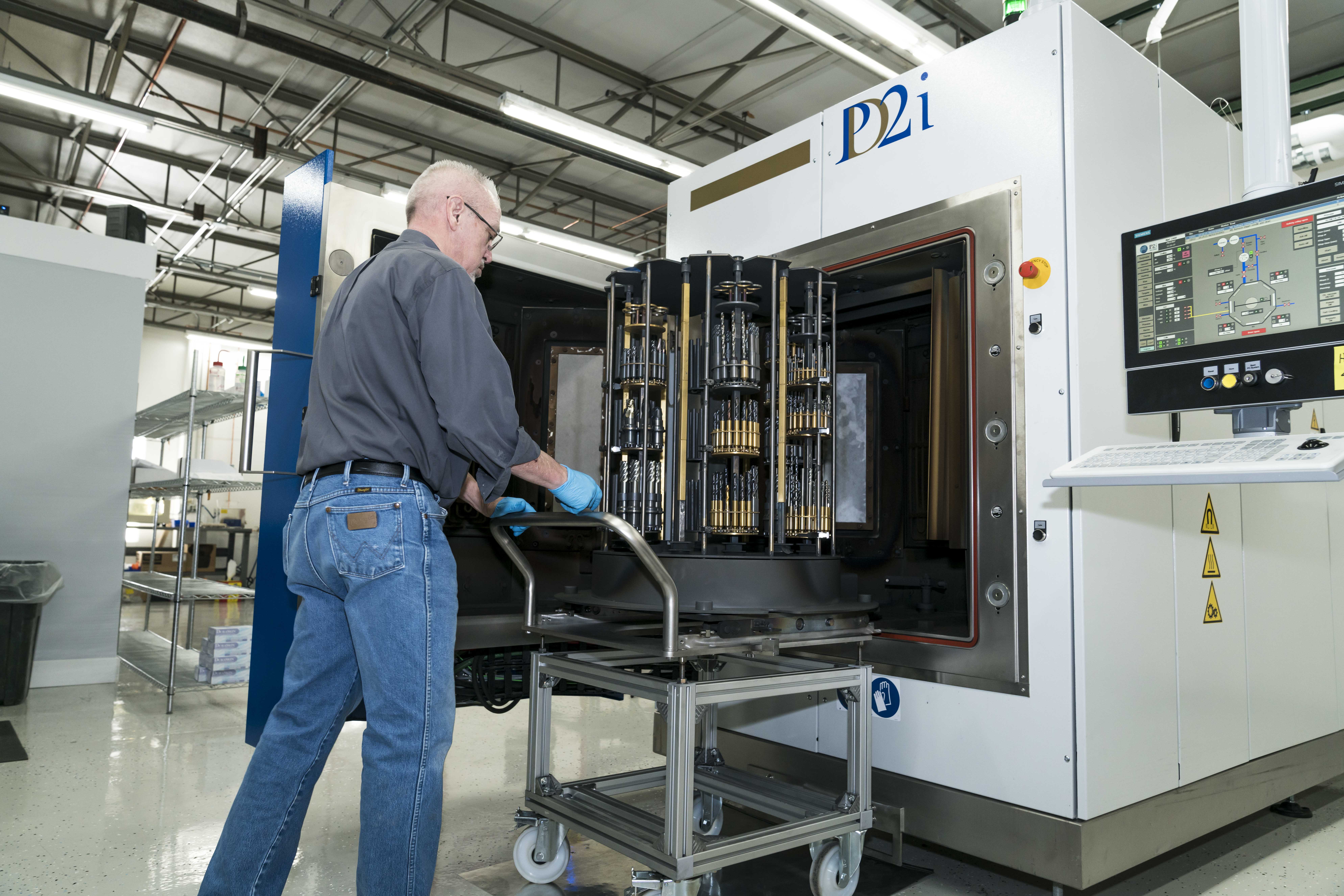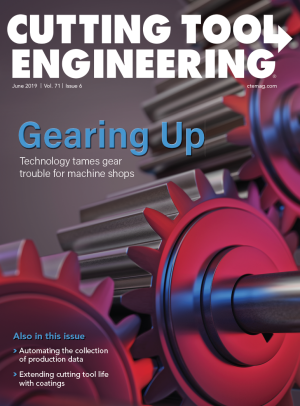When the quantity of cutting tools a company makes can achieve a return on investment in a few years, it makes economic sense to coat tools in-house. Superior Tool Service Inc. made that decision about a year ago and launched its STS Coatings division to coat not only the round tools STS produces but tools from other companies, as well as to decoratively coat a variety of products, such as firearms, said STS President Clint Whitney.
To perform physical vapor deposition coating, Wichita, Kansas-based STS reports that it invested $2.2 million in equipment and hired additional employees. STS has a German-made MpC1000 coating vessel from PD2i that has 12 spindles and can deposit a number of coatings, including TiN, TiCN, AlTiN, Alcron, AuRoRa, Micral TeToN and AlTiSiN.
“I spent a straight year studying and working with some coating shops and with the factory that makes the equipment,” Whitney said.

STS has a German-made MpC1000 coating vessel from PD2i. Image courtesy of Superior Tool Service
STS specializes in making custom tools and can coat different types and sizes of tools at one time. “We really have to tailor our recipes and fixturing to make sure we get the same coating thickness,” Whitney said.
Many applications require a tool that’s received multiple nanoscale layers of different coatings, he added. A chrome coating often is deposited first because of its high level of adhesion, with other layers providing a variety of properties, such as heat and wear resistance. The top layers must be hard and lubricious and have a high coefficient of friction. STS offers coatings as hard as 3,800 HV.
Prior to coating, tools go to the nonaqueous cleaning line, which uses a modified alcohol-based solvent, Whitney said. After being coated, the tools receive a post-processing treatment, such as drag finishing to enhance smoothness or aerolapping to impart a smoother, brighter finish. The latter is primarily for decorative applications.
Once a coated tool becomes too worn, it can be re-ground and re-coated two or more times, Whitney said. “There is a myth out there that some people think you can’t regrind coated tools because you’ll do more damage to your diamond wheel when grinding it. With titanium silicon, yeah, you get a little more wear on your diamond wheel but not enough to stop regrinding.”
Some people also have the misconception that a coating isn’t worth the additional expense, particularly when machining gummy materials. With a cobalt tool, for example, a coating proves effective when cutting such materials even without flood coolant, Whitney said. “If they’re running MQL, a misting application, a coated cobalt tool is going to outperform a noncoated tool.”
He estimates that a coating adds 1% to 5% to the tool cost while extending tool life 100% to 600% but concedes that the advantages of a coating might not be realized when running at a low spindle speed.
In addition to the significant investment in time and money to obtain a coating vessel and learn how to properly operate it, running a coating service requires a substantial amount of equipment maintenance, Whitney said. “Since you are coating everything inside of the vessel, you constantly have to keep up on that and clean.” STS operates the coating machine six days a week and spends one day on maintenance.
As STS Coatings continues to refine and promote its business, it continues to attract customers, Whitney noted. “We’re looking to grow twofold this year.”
For more information about Superior Tool Service Inc., call 800-428-8665 or visit www.superiortoolservice.com.
For more information about Superior Tool Service’s STS Coatings division, view a video presentation at https://www.ctemag.com/news/videos/sts-takes-tool-coating-house
Contact Details
Related Glossary Terms
- Vickers hardness number ( HV)
Vickers hardness number ( HV)
Number related to the applied load and surface area of the permanent impression made by a square-based pyramidal diamond indenter having included face angles of 136º. The Vickers hardness number is a ratio of the applied load in kgf, multiplied by 1.8544, and divided by the length of diagonal squared.
- coated tools
coated tools
Carbide and high-speed-steel tools coated with thin layers of aluminum oxide, titanium carbide, titanium nitride, hafnium nitride or other compounds. Coating improves a tool’s resistance to wear, allows higher machining speeds and imparts better finishes. See CVD, chemical vapor deposition; PVD, physical vapor deposition.
- coolant
coolant
Fluid that reduces temperature buildup at the tool/workpiece interface during machining. Normally takes the form of a liquid such as soluble or chemical mixtures (semisynthetic, synthetic) but can be pressurized air or other gas. Because of water’s ability to absorb great quantities of heat, it is widely used as a coolant and vehicle for various cutting compounds, with the water-to-compound ratio varying with the machining task. See cutting fluid; semisynthetic cutting fluid; soluble-oil cutting fluid; synthetic cutting fluid.
- grinding
grinding
Machining operation in which material is removed from the workpiece by a powered abrasive wheel, stone, belt, paste, sheet, compound, slurry, etc. Takes various forms: surface grinding (creates flat and/or squared surfaces); cylindrical grinding (for external cylindrical and tapered shapes, fillets, undercuts, etc.); centerless grinding; chamfering; thread and form grinding; tool and cutter grinding; offhand grinding; lapping and polishing (grinding with extremely fine grits to create ultrasmooth surfaces); honing; and disc grinding.
- physical vapor deposition ( PVD)
physical vapor deposition ( PVD)
Tool-coating process performed at low temperature (500° C), compared to chemical vapor deposition (1,000° C). Employs electric field to generate necessary heat for depositing coating on a tool’s surface. See CVD, chemical vapor deposition.
- titanium carbonitride ( TiCN)
titanium carbonitride ( TiCN)
Often used as a tool coating. See coated tools.
- titanium nitride ( TiN)
titanium nitride ( TiN)
Added to titanium-carbide tooling to permit machining of hard metals at high speeds. Also used as a tool coating. See coated tools.
- wear resistance
wear resistance
Ability of the tool to withstand stresses that cause it to wear during cutting; an attribute linked to alloy composition, base material, thermal conditions, type of tooling and operation and other variables.



